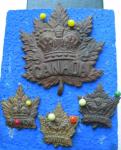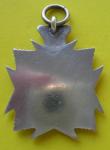-
Posts
13,225 -
Joined
-
Last visited
-
Days Won
22
Content Type
Profiles
Forums
Blogs
Gallery
Events
Store
Everything posted by Mervyn Mitton
-
I have just googled 'Black Maria' and the name come from the US ! There is a a good site showing a picture of the larger type of van - still in use today in the concept of sep. internal cells. However, remember, that this panel is from another area and was on the door. The one illust. is the same cypher and Crown as mine - but, on the side of the waggon. www.met.police.uk/history/black_marias.htm
-
Dmitry - your answer adds a lot to the previous answers. If the Fenians came out of the US, then this would be an accesible and reasonably priced weapon. With the provenance of where it was found - and now an identification of the weapon - Brian has a valuable item that could well be of museum interest. Brian, document all of this , to go with the sword. British 'paddy waggons' - known in UK as 'Black Marias' ( and I'm not sure why - prob. goes back hundreds of years ) were horse drawn. Usually four horses if they were to carry many prisoners and two for the smaller ones. This would have been a smaller one - with two doors. Weight was obviously a consideration and canvas was used a lot - however, it may well have been stretched over a wooden panel and taken off this for framing. Sergeant Brett was inside the van, with the two prisoners. They would have been heavily shackled - the very least would have been leg irons and handcuffs. But, they could have had them in full assize chains. That was a set with leg irons, the chains running up to two arm chains with cuffs + two extra chains with 28lb. (13kilos) cannonballs welded on. Each County had it's own Assize Court and prisoners had to be sent to the County town - from long distances - for trial. The only way to escape was with outside help - as in this case.
-
Always hard to date these pieces accurately - the 'old girl' reigned for so long. Also, despite regulations, local custom could always 'step-in'. They were very autocratic in those days. The gold stripes on the belt that you show were almost badges of rank ? I like the old label on yours - so often they get torn off. Do you know the history of the last example you show. Usually when the two 'prickers' are on the cross belt , it showed infantry - since the prickers represented the cartridge piercers.
-
Leigh - if you look closely, I think you can see that it is embroidery or, woven. It is not bullion. I had an expert collector of headgear in the shop yeasterday - a member of my old Militaria Society - and he said there was no question about it being genuine and of the period. We will alwys take it back .
-

King's Dragoon Guards
Mervyn Mitton replied to Stuart Bates's topic in Great Britain: Militaria: Badges, Uniforms & Equipment
Stuart - Fantastic !! I read your IM before opening - I will hold back on my 1st Dragoon Helmet for now. Some 35 years ago I decided to start a serious collection - the choice was between Helmets or, Police. Still in the Met. then , I decided on Police - partly because helmets take-up space. I have often wished I had made the other decision - and seeing your collection - and it is obviously only part - I wish I could have afforded both. You should put your collection on that display sub-forum, where all members could see it . Mervyn -

BRITISH TEMPERANCE MEDALS
Mervyn Mitton replied to Mervyn Mitton's topic in Great Britain: Orders, Gallantry, Campaign Medals
Tony - that's certainly a lot more than I knew ! Were they allowed to wear them ? Did they get any special priviledges ? Apart from not having hangovers... -

Pietermaritzburg Borough Police Badges
Mervyn Mitton replied to sabrigade's topic in Police Forces of the World
Will - you are so right when you say not much is known about them. They wore a nondescript blue uniform and a cap. For which this is the badge - and a nice example. I think they were set-up when Natal Police were discontinued in 1913 and the S.A.P. took over. They were called Borough Police and I think were based on Durban. I wonder if anyone has a picture? And more info. would be good - I wonder if Brett knows anything of them? p.s. The name - in Zulu - means ' Place of the Elephants' -
There are quite a few old police posters around - but not that many in good condition. I bought about 20 varied ones from a an advert in Ex. & Mart. Turned out an old Sgt. had 'found' them in a cupboard (read station store) burnt the edges to make them 'look old' and tried to sell them on a market stall. Burning the edges of course made them look fakes - which they aren't. I had to have them all framed to cover the edges. I have always assumed that a poster from the Midlands would have been sent to other Forces , if the crime was serious enough.
-

Pre-1945 Bulgarian Police officer uniform
Mervyn Mitton replied to Theodor's topic in Police Forces of the World
Wonderful stuff !!! When you do find a better cap, at least you've got the fittings. -
Brian - thankyou for that well written and concise background to the Canadian period - and as for that battlefield relic ! I don't recognise the sword pattern - would it be possible to have a close-up of the hilt? Like you, I am a believer in trying to put details with an object - we are not just a 'picture gallery' and everyones' contributions have certainly enlarged my knowledge of the period. Similarly, Michael's link adds a lot from the Fenian side. Let's hope more members will contribute.
-
Brian - it must be quite rare to have medals with both of the bars. I am getting 'frustrated' - in all honesty I don't have a clue - apart from the note about them planning to take over Canada - as to what they actually accomplished in Canada. I expect I could Google, but it would be great if a Canadian member could give some details? After all, it's not every day you plan to 'take-over' a stable Commonwealth country ! Going back to the medal, it would be good to have one mounted alongside the panel - should you hear of one, please let me know. Best wishes
-

Miniature Medals
Mervyn Mitton replied to TS Allen's topic in Great Britain: Orders, Gallantry, Campaign Medals
The ones Paul describes are valuable and very sought after. However, we have found in recent years that more general collectors are now turning to miniatures. There are probably two reasons - prices have rocketed for good full size ones - and with mins. you can include gallantry and other rare ones to make interesting sets. Prices can rise quite steeply if mins. can be attribute to a person - the M.C. set I posted is a good example. Earlier mins. - particularly, if silver- will be worth more. A Zulu war example starts at ?50. $85. -
Helen - I was expecting a lot of members to answer your questions. I would say that the difference between the two, is that a replica is for show, and a reproduction is a faithful copy of the original and could, probably be used. Taking your Sharps as an example - an original must be worth a great deal of money - however, a good copy would be just as effective. The Sharps fired a large ball , with a lot of power behind it - I imagine it was the .44 magnum of it's day. However, I am no expert and it would be nice if someone else gave their opinions. With regard to Spain - Toledo was always the centre of the arms trade. Swords and pistols, were of the finest quality and greatly sought after. Even today Spain still produces a great number of replicas of famous guns. When I used to go to Majorca (the island) to see the boat, the shops in Palma were full of imitation firearms - some better than others.
-
I can't remember on which post I saw a topic about police postcards - anyway, these might be of interest. They date to the Edwardian period (1901-1910) and show how the Police were looked on in those days. Always hanging around the kitchens. (Nothing wrong with that - on my Home Beat I could have tea in at least 20 - or,more - shops and schools!)









